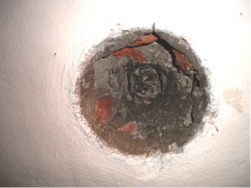https://holocausthandbooks.com/index.php?page_id=49
For a long time the main revisionist talking points on this were Martin Broszat's 1960 statement and the Dachau museum's admission that the "gas chamber" was never actually used.
https://codoh.com/library/document/no-g ... dachau/en/
Thomas Dalton published an article in 2011, "Reexamining the "Gas Chamber" at Dachau." One of Dalton's key points was that the American report 159-L states that room had a high ceiling when in reality it has a very low ceiling. Dalton inferred from this that the ceiling must have been lowered later.
Significantly, the May 15 report also stated that “the ceiling was some 10 feet in height.” Today it is about 2.15 meters, or 6 feet 10 inches. This is a huge discrepancy, and not attributable to misjudgment; clearly the ceiling was lowered, after takeover by the Americans.
https://codoh.com/library/document/reex ... dachau/en/
While Dalton correctly quotes 159-L and is correct that there is a major discrepancy on the ceiling height, Mattogno rejects this conclusion based on photographic evidence.
The evidence in favor of the American forgery seemed convincing, and I too assumed its validity in my paper cited earlier (first published in German: Mattogno 2011, pp. 258-264), but I soon renounced this explanation in the article “The Dachau ‘Gas Chamber’: New Perspectives,” which appeared in 2015 on the Olodogma website, of which the present study is a radical reworking. (pg. 11)
It should be noted that the well-known photograph of May 2, 1945, taken in the “gas chamber” by Illinois Senator Charles Wayland Brooks shows the ceiling of the room in its present state, so that the Americans, who had arrived on April 29, would not have had time to do the work. There is also the American film Nazi Concentration and Prisoner-of-War Camps submitted to Nuremberg as Document PS-2430 (to which I will return later) showing the interior of the crematorium, apparently dating from May 3. If the dates are accurate, there is no doubt that the current ceiling of the alleged gas chamber is original. (pg. 22)
According to USHMM, George Stevens, the director of the concentration camp film, was at Dachau from May 2-7
https://collections.ushmm.org/search/catalog/irn1002425
I would add that I have seen other early accounts that say the room had a low ceiling. For example the article "Find Nazis Removed Stalin Son Jacob, Schuschnigg, Niemoller" from the Washington Post (May 1, 1945): "They had come from a room on the left marked 'Brausebad,' for 'Shower Bath.' It really was a gas chamber, a lok-ceilinged room (sic) about 30 feet square."
It seems then that the contradiction with the ceiling height is most plausibly resolved by concluding that 159-L is simply wrong.
But if the Americans found the room was roughly in the state we seem in the early May photos and films, what then is the explanation for the "fake" showerheads? Mattogno argues that the showerheads weren't fake.
It can be inferred from Document 53 that the shower system was installed before the ceiling slab was poured. The wood planking was made so that the lower surface of the showerheads was left free, and concrete was poured from above, which submerged the whole and left the smooth footprint, which can also be discerned in the surface of the opening (labeled L, Document 53a).
The inscription “Brausebad” was thus not deceptive, but reflected the function of the room.
To verify this explanation, one would have to access the gap between the attic floor and the showerhead-containing ceiling. This scenario is, however, much more reasonable than that of the fake showers inserted from below into an already existing concrete ceiling of the room. It is unknown whether all the pipes of the still-existing showerheads are clogged like the one in Document 52. It is likely that, at an indeterminable time – but when the showerheads had already been officially declared fake – someone (in museum circles) wanted to check whether the showers were really fake, and detached one of them, twisting it with a suitable tool with strong clockwise and counterclockwise movements, so that it caused the pipe to rupture at the point visible in Document 53. If, according to my hypothesis, the pipe was hollow, that is, it was a real connecting pipe, the opening was closed by pressing some cement mortar into it. (pg. 64)
The book is not long but some of it is technical as it frequently refers to diagrams in the appendix. This makes it a bit hard to follow if you read it quickly and casually. I read it closely enough to get the gist of Mattogno's arguments, but I didn't dig into all the technical details. I will probably reread it at some point. But just as a very basic observation I would point out that if the showerheads were in fact fake there would be no need to have anything under the metal covers on the ceiling. Yet we see in photos that there clearly is something there, including what appears to be a pipe.



